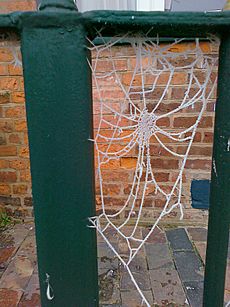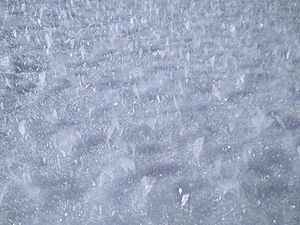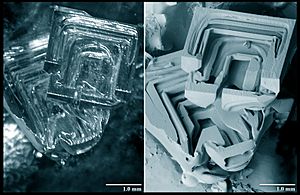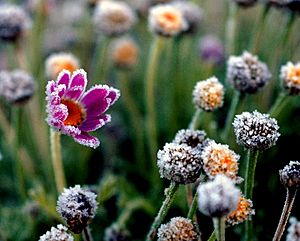Hoar frost facts for kids

Hoar frost is a beautiful type of ice that looks like white, feathery crystals. You can often see it on the ground, on tree branches, wires, or leaves. It forms on very cold, clear nights when the ground and objects cool down a lot.
This happens because heat escapes into outer space faster than it can be replaced. When objects get colder than the air's frost point (the temperature where water vapor turns directly into ice), the moisture in the air freezes right onto them. Sometimes, very cold air can collect in low areas like valleys, creating what's called a flood frost or frost pocket. This can cause hoar frost to form even if the air a few feet above the ground isn't freezing cold.
Contents
What Does "Hoar" Mean?
The word "hoar" comes from an old English word. It means "showing signs of old age." When you see hoar frost covering trees and bushes, it makes them look like they have white, old hair. This is how the frost got its name!
Different Types of Hoar Frost
Hoar frost can look different depending on where it forms. Here are some common types:
- Air hoar is the frost you see on things above the ground. This includes tree branches, plant stems, and power lines.
- Surface hoar looks like fern-shaped ice crystals. It forms directly on top of snow, ice, or other frozen surfaces.
- Crevasse hoar forms inside deep cracks in glaciers called crevasses. Water vapor gets trapped there in calm weather and turns into crystals.
- Depth hoar forms slowly under the surface of dry snow. These crystals grow larger over time, often looking stepped or hollow.
Hoar Frost and Avalanches
When surface hoar forms on snowy hillsides, it can create a risk for avalanches. If a lot of new snow falls on top of these frosty crystals, the fluffy hoar acts like a slippery layer. It stops the new snow from sticking strongly to the old snow underneath.
The best conditions for surface hoar to form on snow are cold, clear nights with light, cold air moving just enough moisture. If the wind is too strong or warm, it can destroy these delicate crystals. This might allow the new snow to bond better. However, if strong, cold winds flatten the crystals without destroying them, the slippery layer can still be a danger. This is because the frost crystals have a different texture and won't stick well to fresh snow.
Other Places You Might See Hoar Frost
In very cold places, if fluffy surface hoar crystals form and aren't covered by snow, strong winds can break them off. These tiny ice pieces can then blow around and form yukimarimo. These are like little ice balls, similar to how dust bunnies form.
You can also find hoar frost in places made by people, like freezers or big industrial cold-storage rooms. If these cold spaces or their pipes aren't well insulated and are exposed to humid air, the moisture will freeze instantly. This frost can build up thickly on pipes, making them less efficient and causing heat to be lost.




